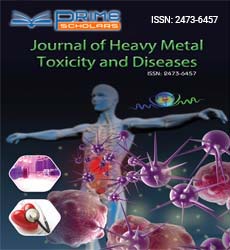Commentary - (2023) Volume 8, Issue 1
Studies of Toxic Effects on the Hereditary Genotoxicity
Jorge Anaya-Gil*
Department of Pharmaceutical Sciences, University of Cartagena, Colombia
*Correspondence:
Jorge Anaya-Gil,
Department of Pharmaceutical Sciences, University of Cartagena,
Colombia,
Email:
Received: 31-Jan-2023, Manuscript No. IPJHMCT-23-15861;
Editor assigned: 02-Feb-2023, Pre QC No. IPJHMCT-23-15861 (PQ);
Reviewed: 16-Feb-2023, QC No. IPJHMCT-23-15861;
Revised: 21-Feb-2023, Manuscript No. IPJHMCT-23-15861 (R);
Published:
28-Feb-2023, DOI: 10.21767/2473-6457.23.8.007
Description
Genotoxicity is the property of chemicals that damage the genetic
information in cells and cause mutations that lead to cancer.
Genotoxicity is often confused with mutagenicity, although
all mutagens are genotoxic, some genotoxic substances are not.
This change can have direct or indirect effects on DNA. Improperly
timed mutagenesis Direct DNA damage leads to activating
events and mutations. Permanent, genetic changes can affect either
the somatic cells of an organism or the germ cells intended
to be passed on to future generations. Cells prevent the expression
of genotoxic mutations by either DNA repair or apoptosis.
However, the damage is not always repaired and mutagenesis
occurs. To test genotoxic molecules, researchers test for DNA
damage in cells exposed to toxic substrates. This DNA damage
can take the form of single and double-strand breaks, loss of excision
repair, cross-links, alkaline labile sites, point mutations, and
structural and numerical chromosomal abnormalities. Cancer is
known to occur when the integrity of genetic material is compromised.
As a result, many sophisticated techniques, such as the
Ames assay, in vitro and in vivo toxicology tests, and the comet
assay, have been developed to assess the potential of chemicals
to cause DNA damage that can lead to cancer. Genotoxins are
chemicals or substances that can cause DNA or chromosomal
damage. Such damage to germ cells can lead to inherited altered
traits (germ cell mutations). DNA damage in somatic cells can
lead to somatic mutations that can lead to malignant transformation
(cancer). Numerous in vitro and in vivo assays for genotoxicity
addressing various endpoints, DNA damage, or its biological
effects in prokaryotic cells (such as bacteria) or eukaryotic cells
(such as mammalian, avian, or yeast) are being developed. These
assays are used to assess the safety of environmental chemicals
and consumer products and to study the mechanism of action
of known or suspected carcinogens. Many chemical carcinogens/ mutagens undergo metabolic activation to reactive species that
covalently bind to DNA, and the DNA adducts so formed can
be detected in cells and human tissues by a variety of sensitive
techniques. Detection and characterization of DNA adducts in
human tissues provide clues to the pathogenesis of human cancers.
Characterization of genetic mutations in human tumors,
together with the known mutagenicity profile of genotoxins in
experimental systems, may provide further insight into the role
of environmental mutagens in human cancer. This is a very rapid
test for mutagens. It uses bacteria of the Salmonella typhimurium
species that have mutations in the histidine operon and are
unable to synthesize histidine. We test compounds to see if they
can induce the reversal of this mutation. This test is very easily
performed by plating His (negative) mutants on agar plates containing
only trace amounts of histidine. Place the crystals or filter
disc containing the solution of the compound to be tested on the
surface of the agar. Bacteria only grow for a short time before
their histidine is used up. After this point, the only bacteria that
can continue to grow colonies are those that undergo reversion
and synthesize their own histidine, histidine prototroph (His+). If
the test compound is not mutagenic, several revertant colonies
will be randomly scattered across the agar plate. If mutagenic,
the number of colonies will cluster around the point where the
compound was added to the plate. Note that a more quantitative
method can be constructed to obtain a dose-response curve for
each compound tested.
Acknowledgement
None.
Conflict of Interest
Author declares that there is no conflict of interest.
Citation: Anaya-Gil J (2023) Studies of Toxic Effects on the Hereditary Genotoxicity. J Heavy Met Toxicity Dis. 8:007.
Copyright: © 2023 Anaya-Gil J. This is an open-access article distributed under the terms of the Creative Commons Attribution
License, which permits unrestricted use, distribution, and reproduction in any medium, provided the original author and source
are credited.

